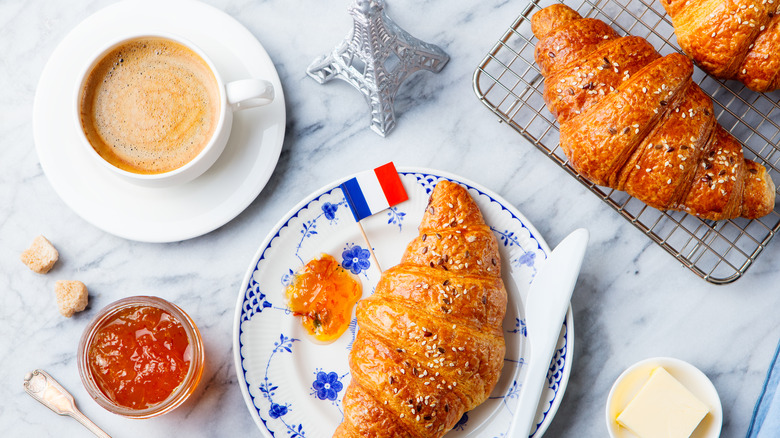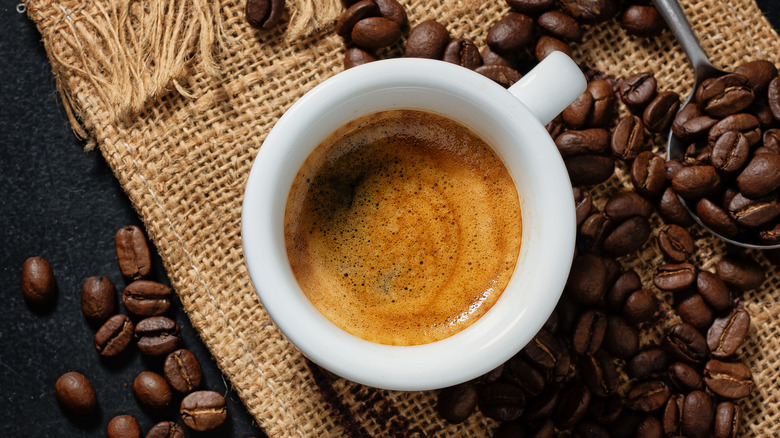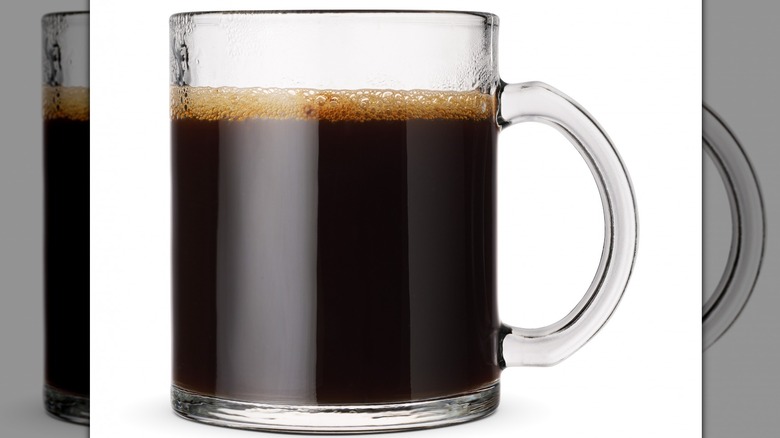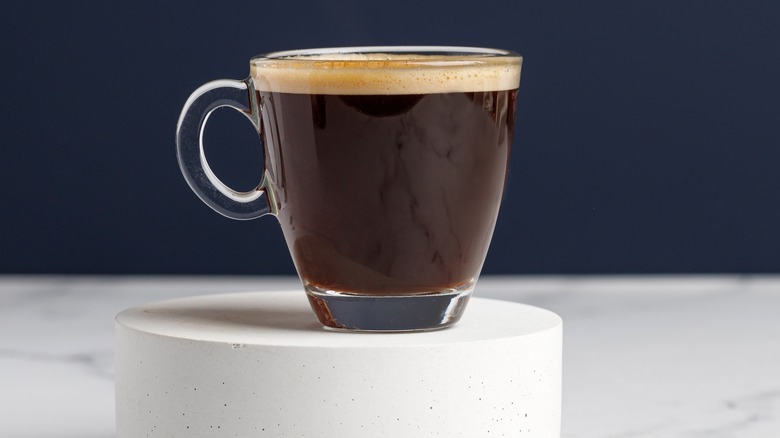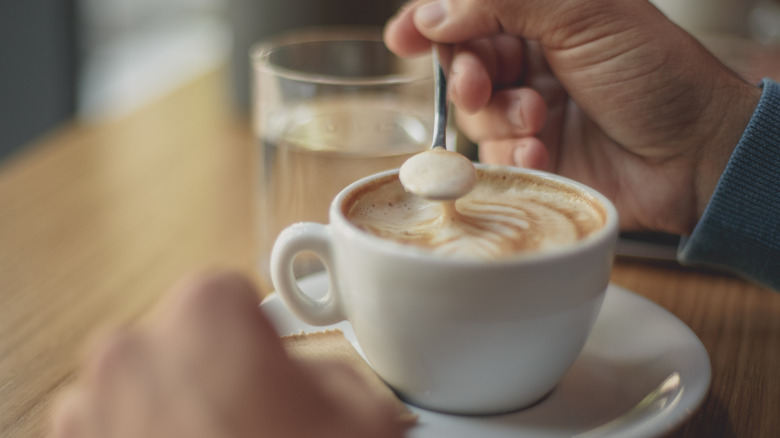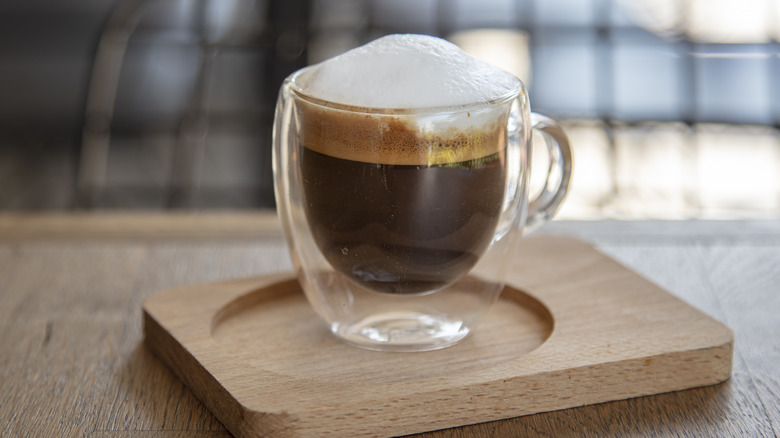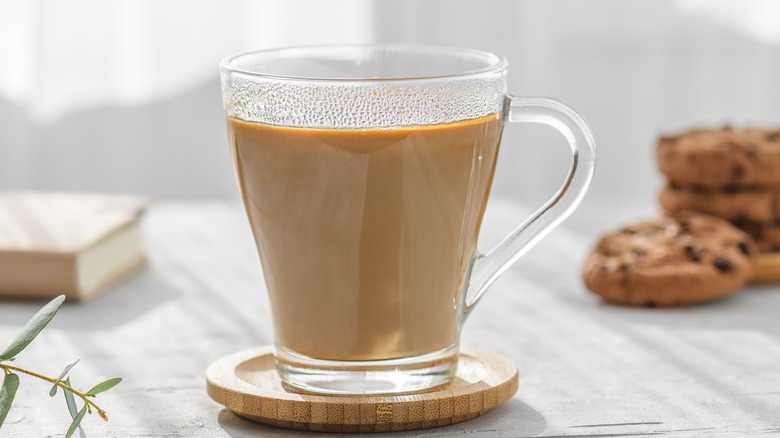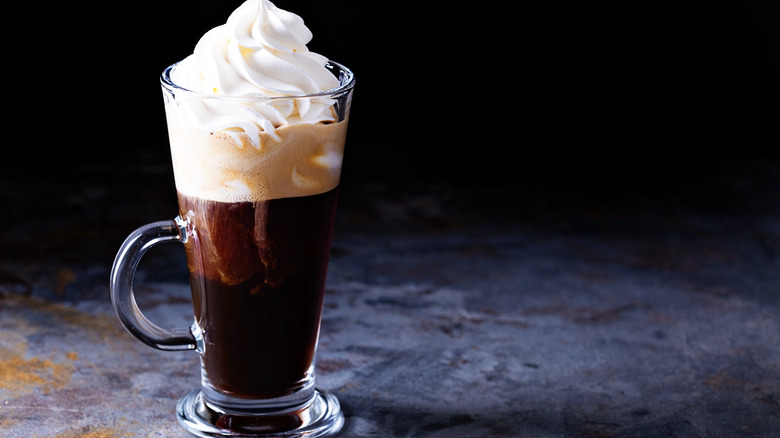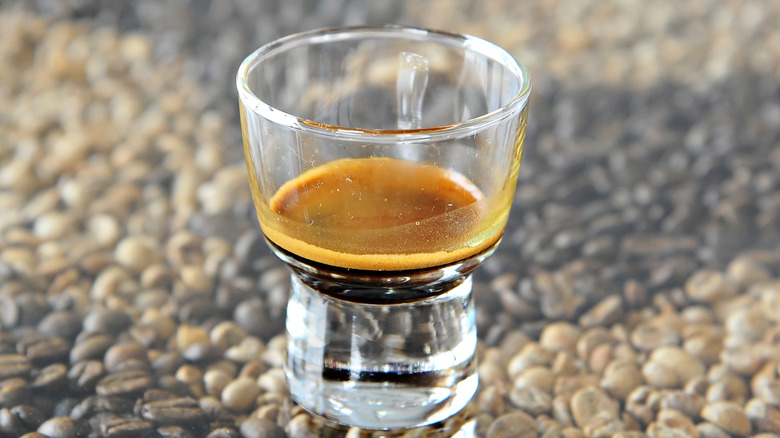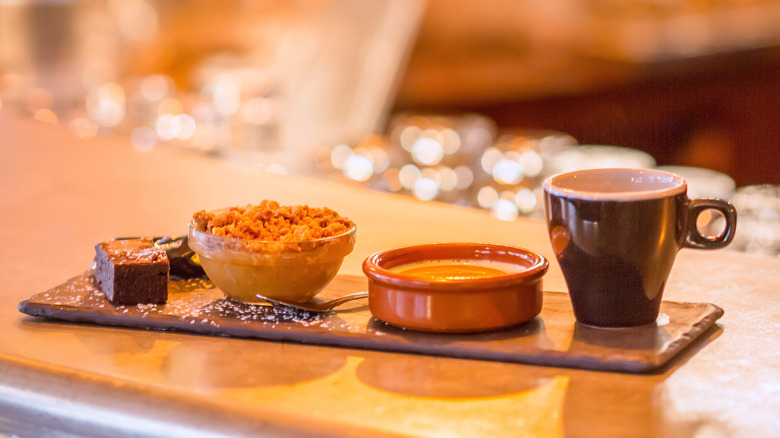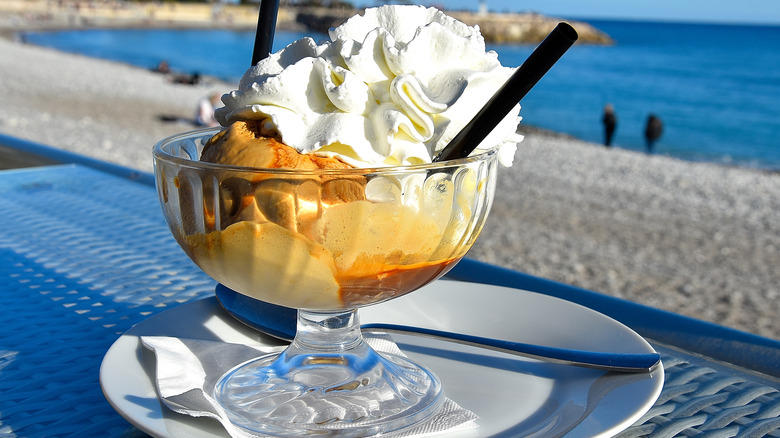10 French Coffee Drinks You Should Try At Least Once
Unlike coffee powerhouses such as Ethiopia, Brazil, and Columbia, France doesn't usually appear on lists of unique coffee ceremonies or best coffee beans. Even still, it would be a mistake to ignore the Hexagon's contribution to coffee culture. In particular, the French are known for their love of leisurely café visits. No matter the time of day, you're guaranteed to see French people smoking cigarettes in between sips of coffee or indulging in foamy café crèmes as they read the newspaper.
Getting the terminology down and understanding the differences between the drinks can be a bit tricky, so we put together this guide to French coffee drinks you should know. In it, you'll discover several types of French coffee and learn what makes each one special. You'll also get insider tips on how and when to order each one so you can avoid committing a coffee faux pas the next time you find yourself in a French café.
1. Café
Even if you don't speak French, you can probably work out that café means coffee in French. Somewhat confusingly, café is also the French word for the place where you drink coffee, but we digress. What you might not realize is that your order won't come out as the typical eight-ounce brewed coffee you're used to getting in the United States. Rather, you'll receive a single shot of espresso in a small cup along with a couple of sugar packets (and a small cookie if you're lucky).
Unless you're used to drinking espresso on a regular basis, you might find this shot of coffee too bitter for your liking. There are a couple of reasons why espresso tastes so different compared to the drip coffee Americans are so accustomed to drinking. The first is that espresso beans are roasted for longer than drip coffee beans. This process extracts essential oils from the bean pod, causing espresso beans to develop a more pronounced flavor. The second explanation is that espresso beans are ground more finely than other types of coffee beans. Finely ground beans slow water down in the machine, meaning that espresso steeps longer than drip coffee does, creating a stronger flavor.
2. Café Américain
This simple coffee owes its name to the American G.I.s stationed in Italy during World War II. Finding the local espresso too strong, the soldiers diluted the strong stuff with a healthy dose of hot water. Initially, Italian baristas would serve the espresso and hot water separately, but they soon started mixing the two together before serving it to the soldiers. As an homage to the beverage's creators, the Italians coined the term caffè Americano, meaning American coffee.
When the French caught wind of the new drink, they translated caffè Americano into French, and the café Américain was born. Although café Américain is the official name, you're more likely to hear it called an Americano, a café allongé (literally elongated coffee), or simply an allongé. Because it's made with espresso, it won't taste exactly like the drip coffee you're used to drinking, but it's about the closest thing you can get to your Mr. Coffee. It's also worth noting that the French typically serve café Américains black. Your order will probably come with a couple of sugar packets but don't expect any milk or cream. Feel free to order some on the side, but be aware that you might have to pay a bit extra.
3. Café décaféiné
There are all kinds of reasons to limit your caffeine intake. Some people find that it causes them to feel jittery or anxious, while others experience an upset stomach. Plus, as most people know, drinking caffeine after three o'clock in the afternoon usually contributes to insomnia. But even if you don't experience any of these short-term symptoms of caffeine consumption, drinking too much can raise blood pressure and interfere with calcium absorption over time (per MedlinePlus).
Given all of the risks associated with caffeine, it's probably a good idea to order a decaf if you've already had your morning cup of coffee. The French word for decaffeinated coffee is café décaféiné, but you'll blend in a lot better if you use the local slang and order un déca. This comes as a shot of decaffeinated espresso, however, you can order a decaffeinated version of just about any French coffee beverage. You might know this already, but it bears repeating — decaffeinated coffee does contain some caffeine. The exact amount varies from place to place, but it's usually somewhere between three milligrams and 15.8 milligrams. That's obviously far less than the 95 milligrams you'll find in a regular coffee, but if you're trying to cut out caffeine completely, you might want to switch up your order.
4. Café crème
Despite its name, don't expect to find any heavy or whipping cream in a café crème. Heck, you won't even find any half-and-half in this confusing beverage. A café crème does contain full-fat milk, however (go figure). We don't blame you for being confused, but not to worry, a café crème is basically the French version of the Italian cappuccino.
That said, we advise against ordering a cappuccino in France. Waiters know what they are, but locals don't usually drink them. That means you'll be charged the tourist price for essentially the same drink. Well, not exactly the same drink. When you order a cappuccino in France, you'll get an espresso topped with milky foam and whipped cream that's dusted with cocoa powder or cinnamon. If you want to avoid the extra charge (and calories), then take our advice and opt for a café crème instead. Be aware that the French also call this drink a café latte, so if you order a latte hoping for an espresso topped with steamed milk, you might be disappointed.
5. Café noisette
Noisette means hazelnut in French, but don't expect any flavored coffee beans or sugary syrups when you order one in France. Rather, the name comes from the light brown color of the coffee, not the taste. A noisette is made by topping an espresso with just a touch of foamed milk. Once the milk is added, the coffee's pleasant hue emerges. Like espressos, noisettes are served in a demi-tasse cup along with a packet of sugar.
If the recipe sounds familiar, it's because you've probably tried one before. Like a lot of coffee drinks in France, the noisette bears a striking resemblance to an Italian drink — a macchiato, in this case. Although you can drink it morning, noon, or night, most French people drink noisettes in the afternoon. It's easy to see why. The espresso provides a much-needed caffeine hit to ward off the post-lunch crash, while the milk gives a bit of sweetness and creaminess to round off the meal. What's more, it's significantly less filling than milky coffee beverages (café crème and café au lait we're looking at you), meaning it's easy to drink, even on a full stomach.
6. Café au lait
Of all of the coffees on this list, café au lait (aka coffee with milk) is probably the best known outside of France. This is interesting because not many French people drink them. Or rather, not many people drink them when they grab a coffee with friends in a café. Instead, the French prefer to drink this milky coffee beverage from the comfort of their own home. That's probably a good thing because café au lait is a decidedly unsexy beverage.
It's made by mixing equal parts of brewed dark-roast coffee and hot milk together. Traditionally, café au laits were made by combining French press coffee and steamed milk but whisked or frothed milk work in a pinch. The resulting drink is smooth, balanced, and drinkable. They're perfect for those who can't stomach the strong taste of coffee in the morning or who want to keep their caffeine consumption to a minimum. Another interesting thing to note about café au laits is that they're usually sipped from a bowl, not from a mug or cup. It sounds strange, but there is a method to the madness. Indeed, the wider opening makes it easy to dip flaky croissants, sugary brioches, and buttery tartines into the liquid.
7. Café Viennois
The French are incredibly proud of their contributions to cuisine, art, and architecture, but they'd be lying if they said they weren't inspired by other cultures. In particular, French pastries and coffees have been heavily influenced by the Austrian city of Vienna. For example, the word viennoiserie refers to breakfast pastries made in the Viennese style. This includes heavy hitters like croissants, pain au chocolat, and brioche, just to name a few.
Besides these beloved pastries, Vienna also gave the French the café Viennois, also known as Vienna coffee. It may look fancy, but this eye-catching coffee drink is surprisingly simple to make. The recipe calls for a single or double shot of espresso topped with whipped cream and a dusting of cocoa powder. As with many drinks on this list, the Viennois has an Italian counterpart. In the Bel Paese, it's known as espresso con panna (aka espresso with cream). Whatever you call it, we can assure you that coffee is always better with whipped cream on top.
8. Café serré
In some cases, bitter espresso is a mistake. For instance, an acrid flavor may be the result of beans that are ground too finely. Finely ground beans are dense, making it difficult for water to pass through and brew the coffee correctly. Similarly, failing to tamp espresso grounds in the basket means that the coffee won't reach proper brewing pressure, again resulting in a bitter shot.
As you can see, all kinds of accidents can result in a bitter shot of espresso. What you may not realize is that it's possible to brew bitter espresso on purpose. In France, they do this by brewing espresso with half the usual amount of water. The result is a concentrated, bitter hit of coffee that's sure to wake you up from any post-meal stupor. Called a café serré, literally a tight coffee, this is one coffee beverage that's not for the faint of heart. You may recognize this beverage as an Italian ristretto, but it's important to note that the Italian version tends to be sweeter and less bitter than a café serré.
9. Café gourmand
With a name meaning gourmet coffee, you know it has to be good. This decadent treat comes with a shot of espresso and a tray of three to five mini desserts. The desserts vary from restaurant to restaurant, but you're likely to find macarons, mini crème brûlées, mini brownies, and chocolate mousse. That said, a well-made café gourmand should feature a variety of textures, flavors, and temperatures. In France, you'll see people ordering this combo as either a goûter (aka afternoon snack) or a dessert.
Compared to other coffee drinks on this list, the café gourmand is a relatively new addition to the French coffee canon. It was first introduced in 1985 by La Criée, a French seafood restaurant chain. Like all great inventions, it was the product of necessity. When it was invented, the economy was speeding up and people were working longer hours. They no longer had time for the traditional seven-course French meal consisting of amuse-bouche, appetizer, main course, cheese course, dessert, coffee, and digestif. So, in an effort to save time, restaurants started combining coffee and dessert into the magnificent treat that we now call the café gourmand.
10. Café Liégeois
More of a dessert than a coffee beverage, café Liégeois is made by pouring a shot of espresso over vanilla ice cream and topping everything with a healthy serving of whipped cream. It's similar to an Italian affogato, but the addition of whipped cream puts a decidedly French twist on this classic summer drink.
The beauty of this drink lies in the simplicity and harmony of the ingredients. There are only three ingredients involved, but the combination of bitter espresso and sweet ice cream makes for a flavor symphony that's tough to top. Not only do the flavors meld together well, but the difference in temperature is sheer brilliance. While the ice cream is busy cooling down the espresso, the espresso is transforming the ice cream into a decadent coffee mix-in. As if that weren't incredible enough, the whipped cream adds a pleasant lightness to the drink, making it as fun to drink as it is satisfying.
Static Media owns and operates Tasting Table and Mashed.
